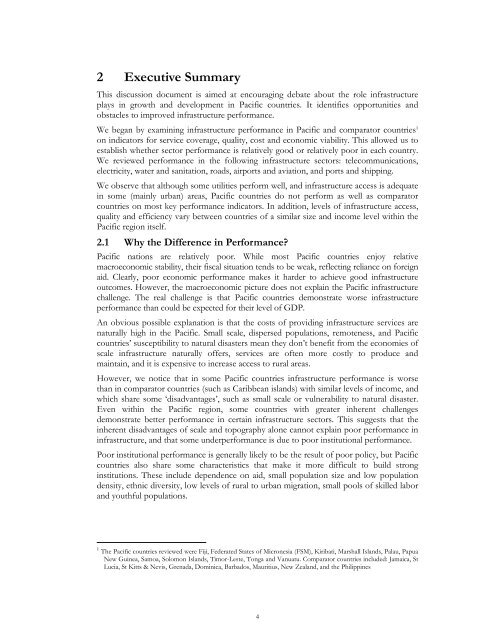EAP - The Pacific Infrastructure Challenge - World Bank (2006).pdf
EAP - The Pacific Infrastructure Challenge - World Bank (2006).pdf
EAP - The Pacific Infrastructure Challenge - World Bank (2006).pdf
Create successful ePaper yourself
Turn your PDF publications into a flip-book with our unique Google optimized e-Paper software.
2 Executive Summary<br />
This discussion document is aimed at encouraging debate about the role infrastructure<br />
plays in growth and development in <strong>Pacific</strong> countries. It identifies opportunities and<br />
obstacles to improved infrastructure performance.<br />
We began by examining infrastructure performance in <strong>Pacific</strong> and comparator countries 1<br />
on indicators for service coverage, quality, cost and economic viability. This allowed us to<br />
establish whether sector performance is relatively good or relatively poor in each country.<br />
We reviewed performance in the following infrastructure sectors: telecommunications,<br />
electricity, water and sanitation, roads, airports and aviation, and ports and shipping.<br />
We observe that although some utilities perform well, and infrastructure access is adequate<br />
in some (mainly urban) areas, <strong>Pacific</strong> countries do not perform as well as comparator<br />
countries on most key performance indicators. In addition, levels of infrastructure access,<br />
quality and efficiency vary between countries of a similar size and income level within the<br />
<strong>Pacific</strong> region itself.<br />
2.1 Why the Difference in Performance<br />
<strong>Pacific</strong> nations are relatively poor. While most <strong>Pacific</strong> countries enjoy relative<br />
macroeconomic stability, their fiscal situation tends to be weak, reflecting reliance on foreign<br />
aid. Clearly, poor economic performance makes it harder to achieve good infrastructure<br />
outcomes. However, the macroeconomic picture does not explain the <strong>Pacific</strong> infrastructure<br />
challenge. <strong>The</strong> real challenge is that <strong>Pacific</strong> countries demonstrate worse infrastructure<br />
performance than could be expected for their level of GDP.<br />
An obvious possible explanation is that the costs of providing infrastructure services are<br />
naturally high in the <strong>Pacific</strong>. Small scale, dispersed populations, remoteness, and <strong>Pacific</strong><br />
countries’ susceptibility to natural disasters mean they don’t benefit from the economies of<br />
scale infrastructure naturally offers, services are often more costly to produce and<br />
maintain, and it is expensive to increase access to rural areas.<br />
However, we notice that in some <strong>Pacific</strong> countries infrastructure performance is worse<br />
than in comparator countries (such as Caribbean islands) with similar levels of income, and<br />
which share some ‘disadvantages’, such as small scale or vulnerability to natural disaster.<br />
Even within the <strong>Pacific</strong> region, some countries with greater inherent challenges<br />
demonstrate better performance in certain infrastructure sectors. This suggests that the<br />
inherent disadvantages of scale and topography alone cannot explain poor performance in<br />
infrastructure, and that some underperformance is due to poor institutional performance.<br />
Poor institutional performance is generally likely to be the result of poor policy, but <strong>Pacific</strong><br />
countries also share some characteristics that make it more difficult to build strong<br />
institutions. <strong>The</strong>se include dependence on aid, small population size and low population<br />
density, ethnic diversity, low levels of rural to urban migration, small pools of skilled labor<br />
and youthful populations.<br />
1 <strong>The</strong> <strong>Pacific</strong> countries reviewed were Fiji, Federated States of Micronesia (FSM), Kiribati, Marshall Islands, Palau, Papua<br />
New Guinea, Samoa, Solomon Islands, Timor-Leste, Tonga and Vanuatu. Comparator countries included: Jamaica, St<br />
Lucia, St Kitts & Nevis, Grenada, Dominica, Barbados, Mauritius, New Zealand, and the Philippines<br />
4

















